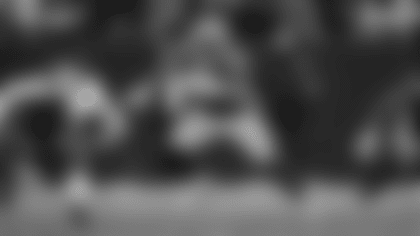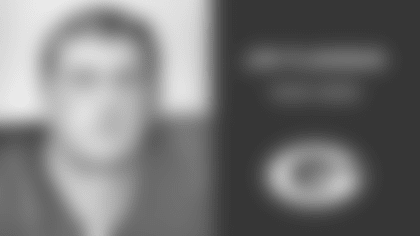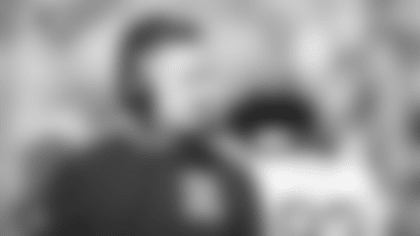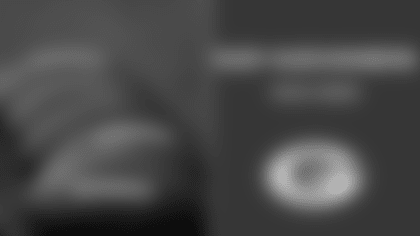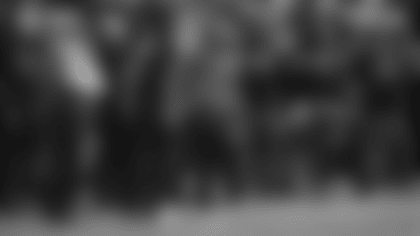The trip was shorter than planned, but when the Green Bay Packers' contingent returned from a U.S. Navy MWR (Morale, Welfare and Recreation) visit to troops in the Middle East, there was no shortage of descriptions.
"It was a blast," safety Derrick Martin said. "Awesome" was linebacker Frank Zombo's word. Cornerback Jarrett Bush termed it "a privilege" and "a truly humbling experience."
Offensive linemen Daryn Colledge and Nick McDonald shared similar thoughts after those five members of the Super Bowl XLV champions, along with assistant equipment manager Tom Bakken, head athletic trainer Pepper Burruss and former Packers fullback William Henderson returned from their weeklong journey last Friday.
Reviewing the itinerary alone, it was quite the adventure. Using a hotel on the island of Bahrain as a home base, the group visited Air Force bases in Turkey and Jordan. Traveling to and fro via helicopter or Osprey aircraft, they spent time on three different Navy vessels. Two of them, an amphibious assault ship named the USS Kearsarge and a transport dock called the USS Ponce, were located in the Red Sea. The third was the USS Carl Vinson, an aircraft carrier stationed between the Gulf of Oman and the Arabian Sea, about 90 miles off the coast of Pakistan.
The carrier was the most impressive just for its sheer size. Bush called it "a city on water," and Colledge said its troop population of 5,000 is "three times what my hometown has." Colledge even got to steer it for a while, and the sense of power and control was different from that of delivering the perfect block on a screen pass, but it will be bragged about just as much in the film room next season nonetheless.
All throughout the trip, which began on Friday, Feb. 11, the group visited with troops and officers, toured ships, watched military demonstrations and signed autographs. They were scheduled to stay one more day, but after returning to the Bahrain airport from the carrier, political unrest in Bahrain made it unsafe for them to return to their hotel.
So they began the journey home, from Bahrain to Kuwait to Washington, D.C., to Chicago and finally back to Green Bay, a 29-hour, 20-minute excursion as timed by Colledge's stopwatch from the moment they left the Carl Vinson.
That gave them plenty of time to reflect on everything they had just experienced, and from a seemingly endless list of highlights, these are some of the moments that stood out the most:
Bunking up—The players stayed overnight on both the Kearsarge and Carl Vinson in military bunks that gave them maybe three feet of breathing room, or half again as much as the actual troops' "racks."
"It was the comfort version," Bush said of the VIP accommodations. "We didn't get what they get. It's kind of like a dorm room, but a little stuffier, muggier."
The players admitted they would have gotten claustrophobic had they been required to live like that for any extended period of time. Even the modified arrangements deepened their appreciation for the lifestyle these sailors accept and embrace.
"I had a bunk, had my own room with a locker and a sink, with the bathroom down the hallway," Colledge said. "For most people, they'd be like, 'This is kind of rough,' but when you see the rest of the ship, you go, 'Whoa, this is luxury.'
"I think the only people who had it better than me were a couple of the officers. They took real good care of us."
Grappling—Martin entertained the crew on the Kearsarge, and his teammates, with a "wrestling" match against a sailor and instructor who was a black belt in either jujitsu or taekwondo, or maybe both.
"I wanted to give it a shot," Martin said. "He put me in a submission hold, had me out quick.
"Then I wrestled another guy (a brown belt) and took him a round. We went about three minutes. I was exhausted and he was ready to keep going. It got their morale up and they said they'll be talking about that until they get back to land."
Catch and catapult—Visiting the Carl Vinson required sitting backwards in a jet for roughly three hours in complete darkness except for the light sneaking through two portholes in the rear. "That thing was a coffin with wings," Colledge said. Zombo nearly got sick from the turbulence.
Suddenly a crew member yelled, "Here we go!" and as the jet was snagged by the cable on the carrier deck, all the passengers felt slammed into their seats. Welcome aboard.
The experience was then the reverse upon departure, as the catapult sent the jet from zero to 150 miles per hour in two seconds, and off they went.
"It beats any roller coaster, that's for sure," McDonald said. "Pretty intense."
The stage show—While on the carrier deck, the group was outfitted with the proper headgear and vests and got to stand mere yards from where F-18 fighter jets were landing and taking off.
Bush recalled how all the players get chills from the sound of military jets doing fly-overs before kickoff at Lambeau Field, but this was something else.
"Imagine the noise that makes when it's right in front of you," he said.
The smooth orchestration of all the arrivals and departures was just as impressive.
"It was like a ballet out there," McDonald said. "It was perfect. Everything was on the dot. It was amazing."
That exercise symbolized something the group witnessed at every turn that made one of the more lasting impressions: all the teamwork.
Whether it was connecting to a visiting supply ship via cables and pulleys to re-stock provisions for the coming week or directing F-18 traffic flawlessly as jets came and went within moments of one another, NFL players couldn't help but relate to the reliance on the group for success.
"The F-18 pilots were like, 'Listen, we have all the fun, but we couldn't do our jobs if it wasn't for these guys, our crew,'" McDonald said. "I thought maybe they'd think, 'I'm a fighter pilot. I'm the best,' but they were showing a lot of recognition for those guys. They work on it together every single day."
The players found out the pilots are under similar scrutiny as well. After a group of F-18s came back from a mission to Afghanistan, they were in a debriefing room reviewing video of all that had transpired.
"They were watching film kind of like we watch film," Zombo said. "We go out and perform and we're critiqued on how we did, and that's how it's done with those planes."
To a man, every player emphasized that the best part of the trip was the time they spent simply chatting with the troops.
They learned about their backgrounds, how they got to where they are. The players shared their own stories, but as much as they liked talking about the Super Bowl, they equally enjoyed being "a piece of home," as Colledge put it – getting to tell the troops the goings on in music world, for example, during the last six or nine or 12 months they've been at sea.
In the end, it's the up-close-and-personal understanding of the sacrifices made willingly and enthusiastically by the military on a daily basis that the players brought back with them.
Colledge said he fully grasped it after chatting with a group of the Carl Vinson's sailors in the Explosive Ordnance Disposal (EOD) division, a group trained to perform the same dangerous work with artillery for which their fellow soldiers have been deployed to Iraq and Afghanistan over the past decade. They just haven't had the chance to put their training into practice yet.
"You'd think in wartime everybody would be scared, that everybody would want to hang back and be happy you're on a ship," Colledge said. "They want to be a part of what their fellow troops are doing. They want to put themselves in danger. They want to fight for their country. I relate it to if we just got to practice football and never got to play it, how disappointing that would be. To know there was a chance they would go out there and die, but to still have the urge and the honor to want to get their hands in the fight …
"Ninety percent of the guys on that ship will never see action. They launch planes and they feed the guys and clean the place and they're the reason the Navy works. Ten percent of them are the guys that are dropping bombs and have their feet in the sand.
"To know those guys want so much to be in there, to fight, it strikes you. To see someone willing to sacrifice so much for somebody they'll never know, that's the humbling thing. You're honored to be in their presence."
To view photo galleries from the trip, click here.





